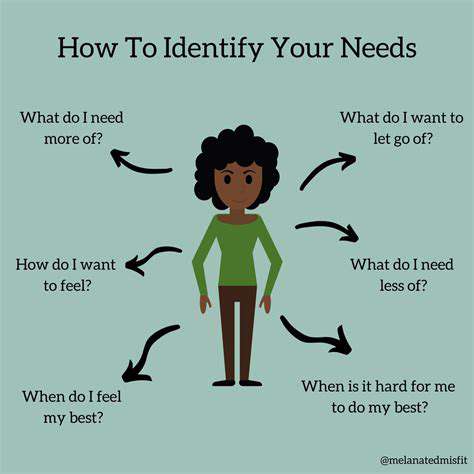Identifying Your Specific Pain Needs

Understanding the Root of Your Discomfort
When dealing with persistent discomfort, the first step is to determine exactly what's causing it. Rather than just noting where it hurts or how bad it feels, dig deeper. Think about recent accidents, changes in your daily routine, or any health issues you might have. Getting to the bottom of what's really causing your pain makes it much easier to find solutions that actually work. Keeping track of when the pain occurs and what makes it better or worse can reveal important clues about what's going on in your body.
It's also worth considering how your emotions might be playing a role. Feelings of stress, worry, or sadness can sometimes translate into physical pain. Paying attention to this mind-body connection is key to addressing pain from all angles. You might discover that certain stressful situations consistently lead to flare-ups.
Examining the Location and Intensity
Being specific about where your pain is located helps doctors pinpoint potential problems. Does the pain stay in one spot, or does it seem to travel to other areas? The more details you can provide about the exact location, how strong it feels, and how long it lasts, the better equipped medical professionals will be to help.
Rating your pain on a simple scale (say, from 1 to 10) creates a useful reference point. This makes it easier to notice if the pain is getting better or worse over time. Also, noting whether certain activities make the pain spike can help identify triggers to avoid.
Analyzing the Timing and Duration of the Pain
Pay attention to when your pain shows up. Does it strike at particular times of day? After specific activities? Or during certain emotional states? Spotting these patterns can be incredibly helpful for both you and your doctor in figuring out what's really going on and how to address it. Keeping a simple pain diary where you note these details can reveal connections you might otherwise miss.
Considering Associated Symptoms
Are you experiencing other symptoms along with the pain? Things like numbness, tingling sensations, swelling, or trouble moving normally can provide important additional clues. These accompanying symptoms sometimes indicate more serious conditions that need prompt medical attention. It's also important to notice how the pain affects your daily life - does it make routine tasks difficult? Is it disrupting your sleep or affecting your mood? Documenting these impacts gives healthcare providers a complete picture of what you're dealing with.
Seeking Professional Guidance
While paying close attention to your symptoms is valuable, nothing replaces professional medical advice. Doctors can put all the pieces together - your symptoms, medical history, and test results - to create a treatment plan tailored just for you. This might include medications, physical therapy, lifestyle adjustments, or counseling to address both the physical and emotional aspects of pain.
Be open with your doctor about everything you've noticed regarding your pain. The more information you share, the better they can help. Don't downplay your symptoms or hesitate to ask questions - good communication leads to better outcomes.
Seeking Recommendations and Reviews

Understanding the Importance of Recommendations
In today's crowded marketplace, recommendations serve as valuable shortcuts for decision-making. They provide social proof that can make unfamiliar products or services feel safer and more appealing. This trust comes from knowing others - especially people we respect - have had positive experiences. For businesses, understanding why recommendations work so well is key to using them effectively.
Studies consistently show that well-reviewed products sell better. Positive word-of-mouth and online reviews directly translate to increased sales and stronger brand reputations. This reality makes actively managing customer feedback an essential business practice in nearly every industry.
Identifying Reliable Sources of Recommendations
Not all recommendations carry equal weight. The most trustworthy often come from established review platforms where customers share detailed, balanced experiences. These first-hand accounts give potential buyers a realistic preview of what to expect.
Recommendations from recognized experts carry particular authority. When specialists with deep knowledge of a field endorse a product, their opinion can significantly influence purchasing decisions, especially for complex or technical items where average consumers lack expertise.
The Role of Reviews in Consumer Decisions
Modern shoppers increasingly rely on reviews as part of their research process. These user-generated assessments provide real-world insights that marketing materials often lack.
With so many reviews available, smart consumers learn to filter them effectively. Understanding how different platforms work and what their rating systems really mean helps people cut through the noise to find genuinely helpful information. Businesses that actively engage with reviews demonstrate their commitment to customer satisfaction.
Analyzing Different Types of Recommendations
Recommendations take many forms, from casual word-of-mouth to formal expert endorsements. A suggestion from someone you know personally usually carries more weight than an anonymous online review. The context and source of each recommendation affects how much trust it deserves.
The Impact of Recommendations on Purchase Decisions
Recommendations reduce the uncertainty that comes with trying something new. This is especially powerful in online shopping, where customers can't physically examine products before buying. Positive reviews often convince people to purchase items they hadn't previously considered.
The psychology behind this is fascinating - people naturally want to make choices that others approve of. Businesses that understand these psychological drivers can craft more effective marketing strategies that leverage the power of recommendations.
